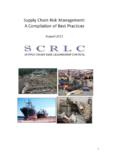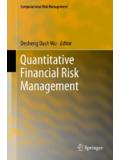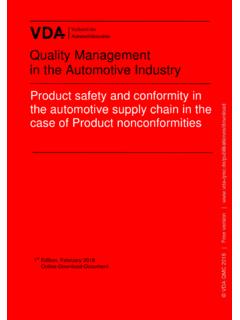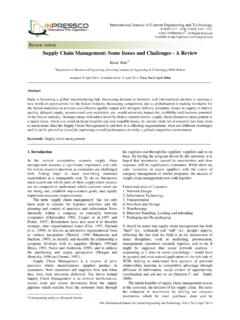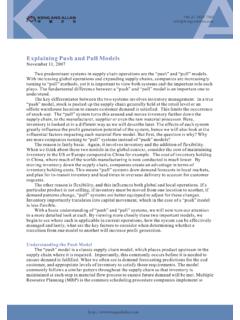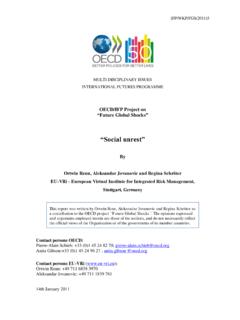Transcription of POWER INFLUENCES WITHIN THE SUPPLY CHAIN
1 POWER INFLUENCES IN THE SUPPLY CHAIN By Michael Maloni and Benton* Fisher College of Business The Ohio State University 600 Fisher Hall Columbus, OH 43210 (614) 292-8868 Email: June 10, 1999 POWER INFLUENCES IN THE SUPPLY CHAIN Abstract Inter-firm POWER often plays a critical role in the SUPPLY CHAIN . This research seeks to expose the detrimental and beneficial effects of POWER on the ability to build integrated, high performance buyer-supplier relationships. In doing so, the research highlights the need for POWER awareness and promotes the benefit of effective POWER management. 2 SUPPLY CHAIN INTEGRATION The concept of logistics has evolved since the 1970's as the strategic coordination of traditional corporate cost centers such as purchasing, manufacturing, transportation, and warehousing. The objective of such coordination is to recognize functional synergies WITHIN the firm to better fulfill customer requirements.
2 Over the last decade, such coordination efforts have expanded beyond the singular firm to inter-firm integration WITHIN the SUPPLY CHAIN , the composite network of firms which play a role in delivering a value package to the ultimate customer. Effective integration of the SUPPLY CHAIN conceptually allows participants to recognize a significant competitive advantage derived from enhancements in responsiveness and cost reduction, leading to improved performance and profitability. Automotive Industry The automotive industry provides a convincing example of the significance of SUPPLY CHAIN management to strategic competitiveness. From the invention of the automobile, auto manufacturers had once been able to maintain worldwide dominance in the industry, enjoying monopolistic market share and profits. In the 1970's, however, Japanese manufacturers began to wrestle away market share with high quality, fuel efficient vehicles that could be delivered to the at prices considerably lower than that of the American competition.
3 The Japanese manufacturers derived the source of such competitive advantage from tight control of the SUPPLY CHAIN through the keiretsu which allowed them to develop best-in-class practices in such key industry drivers as product development, vehicle quality, cost reduction, and cycle times. In their attempt to regain market share and profitability throughout the 80 s and 90 s, manufacturers have emulated the keiretsu coordination strategy through integration with 3 suppliers. The current competitive state of the automotive industry necessitates the use of SUPPLY CHAIN management as a critical driver for competitive positioning WITHIN the industry, and such integration pressures will continue to expand into the next decade. POWER IN THE SUPPLY CHAIN Despite the still maturing comeback of the auto manufacturers, SUPPLY CHAIN integration efforts in the automotive industry have tended to be driven more by issues of POWER and control rather than mutual, win-win intentions.
4 Specifically, the industry retains an imbalance of POWER as five manufacturers account for almost 90% of the market share (Table 1),1 yet the base of supplier firms numbers in the thousands. Such an oligopolistic environment has allowed the manufacturers to authoritatively transfer responsibilities for cost reduction, product development, and inventory management back to the suppliers, forcing them to comply with strict performance guidelines or face replacement. Industry-wide cost-cutting efforts have instigated manufacturer consolidation (such as the Chrysler Corporation and Daimler-Benz AG merger), further elevating the degree of POWER asymmetry in the industry and thus, placing more pressure on suppliers to yield to POWER INFLUENCES . <INSERT TABLE 1> Historically, manufacturers in the automotive industry have followed varying approaches to the balance of cooperation and competition in their purchasing policies.
5 General Motors has tended to take a competitive approach as typified in the early 1990 s with their purchasing head Ignacio Lopez dictating nonnegotiable cost reductions to suppliers. While this policy 4 successfully generated significant savings for GM, many practitioners argue that such benefits were overshadowed by supplier resentment and a lack of synergistic Manufacturers such as Honda and Chrysler, however, have taken a more relational approach. Honda tends to seek a more collaborative relationship with its Tier I suppliers by dispatching Honda resources to supplier site for extended joint improvement efforts, encouraging enhanced communication, and sharing of cost reduction Driven by its Extended Enterprise approach, Chrysler (now DaimlerChrysler) has achieved considerable success through its Supplier Cost Reduction Effort (SCORE) program to drive mutually beneficial cost reduction and product Like GM, Honda and Chrysler each enjoy a significant purchasing POWER advantage, yet each tends to de-emphasize this leverage, focusing on a more relational SUPPLY CHAIN orientation.
6 Many practitioners would consider POWER to be an omnipresent, unmanageable part of everyday business. Given a firm such as General Motors which sources $70 billion annually, there may be little motivation for a POWER holding firm to regulate its authority and likewise little hope for a supplier to escape the wrath of this POWER . Nonetheless, inter-firm POWER retains the potential to upset the mutuality of SUPPLY CHAIN relationships and subsequently presents a barrier to the win-win integration process so frequently promoted in the current literature base. Thus, it is the contention of this paper that SUPPLY CHAIN strategy or research which does not account for the INFLUENCES of POWER can not be entirely realistic or implementable. A wealth of POWER research (see literature review) examines POWER INFLUENCES from the marketing channel perspective with a considerable amount focusing on the auto industry.
7 It is 5 not judicious, however, to extend the findings from such research not only to other industries but even to different echelons ( supplier-manufacturer) WITHIN the SUPPLY CHAIN of the same industry due to differences in the POWER environments. In the case of the automotive industry, the relationship between manufacturer and dealer tends to of co-dependency, and dealer consolidation over the last decade has created a fairly equitable POWER struggle between the two parties. On the other hand, despite the current push toward relational integration, supplier-manufacturer relationships in the auto industry tend to be extremely competitive, and the manufacturers maintain a relatively lop-sided POWER advantage over suppliers. Thus, while the marketing channel POWER research might provide a sensible foundation for POWER research, it is na ve to assume that the findings from such can be directly applicable to other relationships in the SUPPLY CHAIN , even in the same industry.
8 For these reasons, research is needed on the supplier-manufacturer side of the automotive industry as well as other industries to ensure the topic of POWER is rigorously and holistically covered by SUPPLY CHAIN literature. Based on an analysis of the automotive industry, this paper seeks address this void with an investigation of POWER INFLUENCES in supplier-manufacturer relationships from the view of the supplier. The research first seeks to define and evaluate specific sources of POWER WITHIN the industry then shed practical evidence as to how such POWER sources affect critical SUPPLY CHAIN relationship elements. Finally, the research seeks to reveal how this POWER -affected relationship INFLUENCES the performance of the CHAIN . By accomplishing such goals, the research attempts to offer practical insight for the implementation of SUPPLY CHAIN integration in addressing three critical research questions: 6 How does inter-firm POWER affect integrated relationships WITHIN the SUPPLY CHAIN ?
9 How does a POWER -affected SUPPLY CHAIN relationship affect the performance of the CHAIN ? Can SUPPLY CHAIN management exist in the presence of POWER asymmetry, and if so, what role does POWER play in SUPPLY CHAIN strategy? Literature Review: SUPPLY CHAIN Integration It is argued by some that a key driver in the decline of competitiveness in the international marketplace has been fueled by a lack of emphasis on intangible benefits such as supplier Traditionally, manufacturers have maintained a distant, competitive SUPPLY CHAIN environment with large supplier bases in order to obtain low cost Over the past two decades however, firms have looked toward a more relational attitude of sharing information and planning WITHIN the CHAIN to position the entire CHAIN as a source of strategic competitive There has subsequently been a maturing assemblage of partnership research with both a general inter-organizational focus8 and a logistics The potential benefits of these integrated SUPPLY CHAIN relationships (Table 2)
10 Stem primarily from reductions in uncertainty and costs for partners as well as increases in responsiveness derived from functional synergies. Carter and Narasimhan highlight enhanced material flow and product development as well as improved flexibility, quality, service, and Sources which attempt to verify partnering benefits generally find that such rewards tend not to be realized until several years after alliance formation, hinting at the necessary long-term nature of the 7 <INSERT TABLE 2> Though no quantifiable boundary exists between a transactional and an integrated relationship, several key elements make the integrated relationship unique including trust,13 cooperation,14 and (See Table 3 for relationship element definitions.) Furthermore, though conflict may be an omni-present factor in any relationship,16 the ability to manage and resolve conflict (conflict resolution) remains a necessary factor for the long term survival of the relationship.
